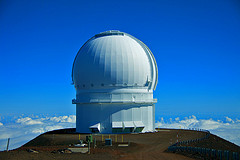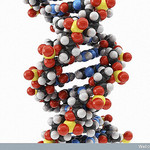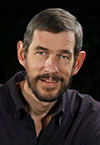Three areas observed by science where we see evidence of ultimate reality are astrophysics, DNA, and quantum physics.
 Ultimate Reality and Astrophysics
Ultimate Reality and Astrophysics
The Big Bang, the universally accepted theory of how the universe was formed, requires an antecedent and intelligent power to have made it happen. In other words, the Big Bang couldn’t have happened without someone we call “God.” No wonder we don’t find too many atheists among astrophysicists.
The weird thing is that everyone thought the expansion of the universe was slowing down—what one would expect with an explosion. But now we find that it’s speeding up—and everyone is confused. Forgive me if I see God behind all of this. I think he must have fun.
However the universe acts, the parameters for life throughout it are constant. No matter where you might go if you could, physics are unvarying. And universally, any life beyond a few cells has to be carbon based. I once ascribed to what I called “Star Trek theology,” in which different places in the universe might have different physics and chemistry for different life forms with different definitions for life. And maybe Jesus became an alien and went to those planets and died for their sins too. Nice idea, but it doesn’t work, except for science fiction fantasies. The bases and boundaries for life in our galaxy equal those in every other.
So far, when these parameters for life have been calculated, nowhere else in the entire universe has anyone found another galaxy or solar system or planet that is life sustaining as we know it.
In studying the universe, astrophysicist Hugh Ross finds thirty-five parameters of masses, ratios, distances, forces, and energy levels on the cosmic scale—all falling within hair-thin narrow ranges—that are necessary for any kind of life to exist anywhere. In looking at our own galaxy, sun, earth, and moon, he finds an additional sixty-six similarly narrow parameters for the existence of earthly life as we know it.
Here’s the fun part (and we thought only little kids used numbers like this): Ross calculates the likelihood of a life-sustaining solar system and planet forming by chance. He finds “less than 1 chance in 10144 (trillion trillion trillion trillion trillion trillion trillion trillion trillion trillion trillion trillion) exists that even one such planet would occur anywhere in the universe.”
I get the idea that this big ball we’re living on is a special place and we’d better take care of it.
NASA’s Kepler spacecraft is a sophisticated and noble attempt to hunt for such a habitable place. Chances are it will find what we already know: any camping is going to be on planet earth and no more.
If that doesn’t show you how important we are to this Creator, who went to all that exacting work to fine-tune this place we live, you might need counseling.
We are his diamond in the universe. And judging by the size of the place, he’s got big hands.
Ultimate Reality and DNA
 People often talk casually about their DNA and how it determines who they are. So I wondered if that might be a place where I could connect with God.
People often talk casually about their DNA and how it determines who they are. So I wondered if that might be a place where I could connect with God.
Under super magnification the deoxyribonucleic acid (DNA) molecule looks like a spiraling ladder, commonly called a “double helix.” DNA is made up of four chemical bases linked like ladder rungs along the spiraling sugar and phosphate helix. The precise binary sequences of these chemicals form information codes, like those in computer software but infinitely more complex.
DNA contains the genetic instructions—twisted, compacted and packaged into X-shaped chromosomes—that enter and direct every nucleus of living cells. They might be human, animal, plant, even virus (though viruses act differently—they’re always bad boys). Viruses are quite simple, while humans have twenty-three pairs of chromosomes (including those pesky Y chromosomes responsible for all the men in the world).
A set of human chromosomes contains as many as three billion codes, all duplicated in every cell of our bodies. This is a more tightly packed, complex set of information than anywhere else in the universe. If you printed them all out into four-hundred-page books, it would take five thousand (yes, 5000) books to contain the information of your DNA molecules in the nucleus of a single cell.
DNA directs the building of each protein in an organism and makes every living cell an exact part of the living creature it becomes or maintains. To do that, it includes a jaw-droppingly intricate system for self-replication.
DNA is more complicated than anything else on earth. And the information of the DNA is independent from the structure. That means it did not—and could not—have randomly evolved, any more than a computer program that runs the world could evolve out of computer hardware. Someone carefully created our DNA. His fingerprint is on every cell of our bodies. You can’t get more intimate than that.
Ultimate Reality and Quantum Physics
 Quantum physics is one of my favorite subjects, especially since I don’t understand it. But that’s okay, because it’s the only subject I know of where the more you learn about it, the less you understand. Mater, or energy, at the subatomic level is bizarre and flagrantly breaks the laws of the Newtonian physics that have explained the natural world for hundreds of years.
Quantum physics is one of my favorite subjects, especially since I don’t understand it. But that’s okay, because it’s the only subject I know of where the more you learn about it, the less you understand. Mater, or energy, at the subatomic level is bizarre and flagrantly breaks the laws of the Newtonian physics that have explained the natural world for hundreds of years.
Quantum physics is classical physics turned upside-down, or inside-out, or backward, or… This stuff is the weirdest part of creation and defies almost everything we think we know about the natural world. Which is why I’ll happily honk if you have a bumper sticker that says “Quantum physicists have more fun.”
At the subatomic level nothing is static or predicable. Particles within an atom aren’t simply particles. Protons and neutrons are made of quarks. And the orbiting electrons don’t act like mini-planets but rather like a blur of probabilities of where they might be. And even the nucleus seems to appear and disappear all the time. Where does it go? Rather than being the smallest form of matter, as most of us think, atoms could be understood as being concentrated bits of information.
It gets weirder. Try “superposition,” the principle that a particle is simultaneously in all possible states at the same time—until one looks at it. And it’s like a mischievous kid. It will behave differently when you look at it than it will when you don’t look at it. For example, when you look at it, it may act like a particle, and when you stop looking at it, it may act like a wave. Or vice-versa. More than being solid micro-gizmos of reality, particles exist in a multiplicity of possibilities. The instant one checks, the particle snaps into one of those positions. Don’t ask.
If you isolate a single electron in a box then partition the box in two, the electron’s waves can be detected in both halves. And the “ghost” of the electron (that is, the possibility that it’s really there) is observable in both. So, in which partition is the actual electron? Answer: In whichever one you look. When you observe either one of the box’s half chambers, the electron and its waves are detectable. But at that instant in the unobserved half of the box, any and all evidence of the electron and its waves disappears. Conclusion: the difference between probability and reality depends on what you look at.
That’s what’s so weird. Our observation, or someone’s observation, is a part—a determining part—of everything that exists.
Simply said, things hold together under the watch of an “observer.” Theorists speak of the “Ultimate Observer,” that all-encompassing universal consciousness that must be somehow watching over or be resident in all matter of the physical universe. Otherwise, all of creation would go haywire and morph into who-knows-what.
Disagree if you like, but it seems fairly obvious who the Ultimate Observer is, or shall I say has to be. The traditional term we use is “God.” When the Bible says that God is watching us or has his eye on us, it may be that he is doing much more than checking us out. The world of quantum mechanics suggests that God’s watchfulness may be what holds everything in our world together. And everything in the whole universe.
Don’t worry that quantum physics doesn’t make much sense. It never will and is probably not supposed to—which is natural if we see it as evidence of God.
After centuries, physics still has no answer for where mass comes from. But that is changing with the gargantuan particle accelerator near Geneva, Switzerland. There scientists are attempting to understand the “The Higgs boson,” a particle that is theorized to explain how everything gets its mass and to demonstrate that at the universe’s origin, everything was (or is) ordered.
I’m not pretending to be a scientist here. I’m only identifying the fascinating world of creation that has God’s identity woven through all of it. The smallest particle and the farthest reach of the universe are good places to connect with God—or at least the fingerprints he leaves us.
—-
Top photo credit: Hector Parayuelos www.flickr.com/photos/ohhector/6832125158/
Middle photo credit: Wellcome Images www.flickr.com/photos/wellcomeimages/5814818738/
Lower photo credit: marsmettnn tallahassee www.flickr.com/photos/79996062@N08/8168012934/







